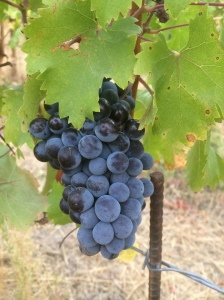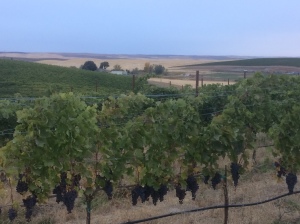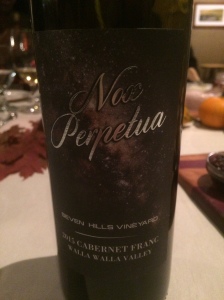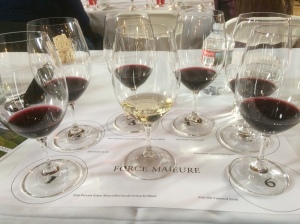 We waited outside the Marcus Whitman hotel in Walla Walla Washington, having been separated into groups. It was a Wine Bloggers’ Conference dinner expedition. Each group was picked up by different cars. A caravan of 1950’s cars picked up one group. A caravan of limousines picked up the next group. Next we saw a late model, maybe 20 year old unmarked van pull up. That was our ride.
We waited outside the Marcus Whitman hotel in Walla Walla Washington, having been separated into groups. It was a Wine Bloggers’ Conference dinner expedition. Each group was picked up by different cars. A caravan of 1950’s cars picked up one group. A caravan of limousines picked up the next group. Next we saw a late model, maybe 20 year old unmarked van pull up. That was our ride.
As we drove through winding roads and up hills further out into the country, there were some nervous jokes about perhaps we were being kidnapped. The young man driving the van assured us we were not being kidnapped. Then he introduced himself, Jason Fox, owner of Lagana Cellars. He was driving us out to his vineyards.
 The outskirts of Walla Walla are still quite rural, true farmland. When we reached the Lagana Cellars vineyards we were awestruck by the beauty of the land, and greeted energetically by Heinie the vineyard dog.
The outskirts of Walla Walla are still quite rural, true farmland. When we reached the Lagana Cellars vineyards we were awestruck by the beauty of the land, and greeted energetically by Heinie the vineyard dog.
Some writers believe passionately that they can only write about what they have seen and what they have experienced. The tactile, physical details must be experienced in order to be recorded. Some writers believe passionately that writing requires empathy; the ability to understand the experience of another without actually experiencing it themselves. Does imagining lead to inaccuracies? Are they justifiable inaccuracies? Or in order to write well, should one be tied only to his or her own experiences?
 After visiting the vineyard we were whisked away by our hospitable kidnappers to a Lagana wine dinner which opened with a butternut squash bread salad paired with Lagana Sagemoor Vineyard Roussanne that was floral and round and perfect with the salad. Our entree was steak au poivre paired with the Breezy Slope Vineyard Pinot Noir. Pairing a Pinot with a steak is a bold choice, but the Pinot was bold and ripe with enough structure to stand up to the steak. Dessert was really elegant, a cheese plate served with Seven Hills Vineyard Cabernet Franc, a Franc with all the inorganic earthiness you’d expect from Washington state.
After visiting the vineyard we were whisked away by our hospitable kidnappers to a Lagana wine dinner which opened with a butternut squash bread salad paired with Lagana Sagemoor Vineyard Roussanne that was floral and round and perfect with the salad. Our entree was steak au poivre paired with the Breezy Slope Vineyard Pinot Noir. Pairing a Pinot with a steak is a bold choice, but the Pinot was bold and ripe with enough structure to stand up to the steak. Dessert was really elegant, a cheese plate served with Seven Hills Vineyard Cabernet Franc, a Franc with all the inorganic earthiness you’d expect from Washington state.
Jason Fox fell in love with wine after a taste of 2005 Chateau La Croix de Gay Pomerol and moved out to Walla Walla to study enology. After learning and working as a winemaker, he has opened his own winery. The courage and the passion that must take is incredibly admirable. He cannot know all the details of what he must do. There’s a certain faith, a certain element of imagination required and yet, there is a lot of tactile knowledge and experience required. Good wine making, like good writing takes both actual experience and deep imagination.
 Near the banks of Lake Garda along the 100 mile coastline in both the Veneto and Lombardy regions of northern Italy grows a grape that is not terribly well-known. There are so many grapes grown in Italy, they can’t all be famous. Everyone knows Pinot Grigio, the distant relative of Pinot Noir. Many have heard of Trebbiano di Soave of the Veneto region and Verdicchio of the Marche region. But not many have heard of Turbiano. It is related to both Trebbiano di Soave and Verdicchio di Marche and makes up 95% of the vineyards of Lugana along the banks of Lake Garda.
Near the banks of Lake Garda along the 100 mile coastline in both the Veneto and Lombardy regions of northern Italy grows a grape that is not terribly well-known. There are so many grapes grown in Italy, they can’t all be famous. Everyone knows Pinot Grigio, the distant relative of Pinot Noir. Many have heard of Trebbiano di Soave of the Veneto region and Verdicchio of the Marche region. But not many have heard of Turbiano. It is related to both Trebbiano di Soave and Verdicchio di Marche and makes up 95% of the vineyards of Lugana along the banks of Lake Garda. Founded in 1896, Bodegas Lustau of Jerez de la Frontera Spain is on a mission. That mission is to bring a knowledge and love of Sherry to the world. Part of their mission implementation is a traveling Sherry certification program. From the outset the message was clear; Sherry comes in many styles and is meant to be enjoyed with many types of food.
Founded in 1896, Bodegas Lustau of Jerez de la Frontera Spain is on a mission. That mission is to bring a knowledge and love of Sherry to the world. Part of their mission implementation is a traveling Sherry certification program. From the outset the message was clear; Sherry comes in many styles and is meant to be enjoyed with many types of food. Force Majeure, a Washington winery owned by Paul and Susan McBride has 23 planted vineyards in the Red Mountain district. Those vineyards represent nine different soil types, from chalky to sandy to limestone to clay. Many of the vineyards are on steep, south-facing slopes. It is the McBrides’ goal to produce wines that have ‘a personality, a soul and a story to tell.’ To meet that goal they have turned to Todd Alexander, a winemaker who has worked with Screaming Eagle, Bryant Family and Cade.
Force Majeure, a Washington winery owned by Paul and Susan McBride has 23 planted vineyards in the Red Mountain district. Those vineyards represent nine different soil types, from chalky to sandy to limestone to clay. Many of the vineyards are on steep, south-facing slopes. It is the McBrides’ goal to produce wines that have ‘a personality, a soul and a story to tell.’ To meet that goal they have turned to Todd Alexander, a winemaker who has worked with Screaming Eagle, Bryant Family and Cade.
 When you think of sherry, what do you picture? I picture the inexpensive cooking ‘sherry’ one finds on the grocery store shelf, the same bottle tucked away in the back of the cupboard that comes out when making clams, or a melon salad. But the sherry of Andalusia is nothing like that back-of-the-cupboard cooking sherry.
When you think of sherry, what do you picture? I picture the inexpensive cooking ‘sherry’ one finds on the grocery store shelf, the same bottle tucked away in the back of the cupboard that comes out when making clams, or a melon salad. But the sherry of Andalusia is nothing like that back-of-the-cupboard cooking sherry.